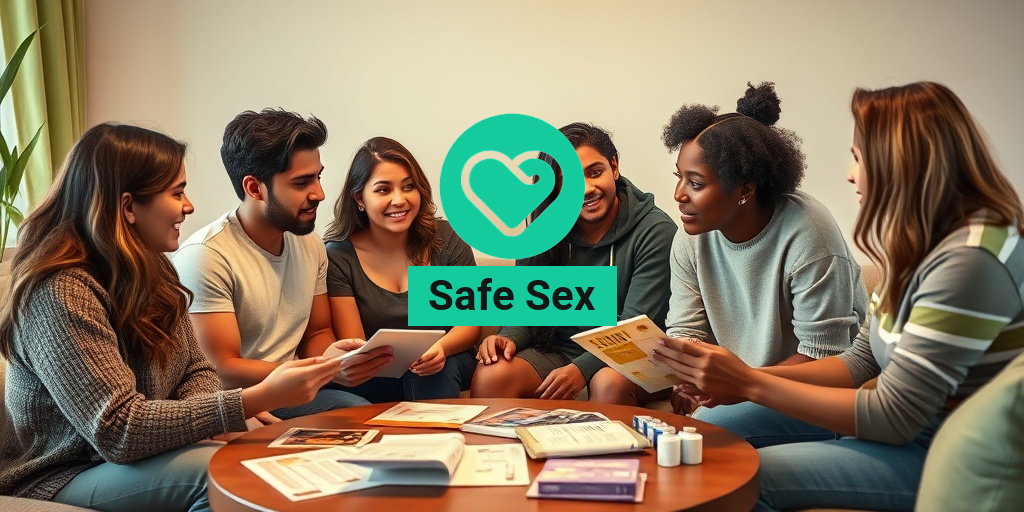What Is Safe Sex?
Safe sex refers to practices that reduce the risk of sexually transmitted infections (STIs) and unintended pregnancies. It encompasses a variety of methods and strategies aimed at protecting both partners during sexual activity. The concept of safe sex is not just about using condoms; it also involves open communication, understanding your partner’s sexual health, and making informed choices.
The Importance of Safe Sex
Engaging in safe sex is crucial for several reasons:
- Prevention of STIs: Safe sex practices significantly lower the risk of transmitting infections such as HIV, chlamydia, gonorrhea, and syphilis.
- Unplanned Pregnancies: Utilizing contraceptives effectively can help prevent unintended pregnancies, allowing individuals to plan their futures.
- Emotional Well-being: Knowing that you are taking precautions can lead to a more relaxed and enjoyable sexual experience.
In essence, safe sex is about making informed choices that prioritize your health and the health of your partner. It’s essential to understand that safe sex is a shared responsibility, requiring both partners to be proactive in their sexual health.
Benefits of Safe Sex
Practicing safe sex comes with numerous benefits that extend beyond just physical health. Here are some key advantages:
1. Reduces the Risk of STIs
One of the most significant benefits of safe sex is the reduction in the risk of STIs. By using barriers such as condoms, dental dams, or internal condoms, you can significantly decrease the likelihood of transmitting infections. Regular STI testing is also a vital part of maintaining sexual health.
2. Prevents Unplanned Pregnancies
Safe sex practices, particularly the use of contraceptives, play a crucial role in preventing unplanned pregnancies. There are various methods available, including:
- Condoms: Both male and female condoms are effective barriers that prevent sperm from reaching the egg.
- Birth Control Pills: Hormonal contraceptives can regulate ovulation and prevent pregnancy.
- IUDs: Intrauterine devices are long-term solutions that can prevent pregnancy for several years.
Choosing the right method depends on individual preferences and health considerations, so consulting with a healthcare provider is recommended.
3. Enhances Communication
Engaging in safe sex encourages open communication between partners. Discussing sexual health, preferences, and boundaries fosters trust and intimacy. This dialogue can lead to a more satisfying sexual experience and strengthen the relationship.
4. Promotes Overall Health Awareness
Practicing safe sex often leads to increased awareness of overall health. Regular check-ups and discussions about sexual health can help individuals stay informed about their bodies and any potential health issues. Resources like Yesil Health AI (yesilhealth.com) can provide evidence-based answers to questions about sexual health and safe practices.
5. Empowers Individuals
Understanding and practicing safe sex empowers individuals to take control of their sexual health. It allows them to make informed decisions that align with their values and life goals. This empowerment can lead to healthier relationships and a more fulfilling sex life.
6. Safe Sex During Special Circumstances
There are specific situations where safe sex becomes even more critical, such as:
- Safe Sex During Pregnancy: Pregnant individuals should continue to practice safe sex to protect both their health and that of their baby.
- Safe Sex with Herpes: Those with herpes can still have a fulfilling sex life by using protection and communicating openly with partners.
- Safe Sex Before Period: Understanding your cycle can help in planning safe sex practices, especially if you are trying to avoid pregnancy.
In conclusion, safe sex is a vital aspect of sexual health that offers numerous benefits. By prioritizing safe practices, individuals can protect themselves and their partners, leading to healthier and more satisfying sexual experiences. Remember, safe sex is not just a personal choice; it’s a shared responsibility that fosters trust, communication, and overall well-being. 🌟

Safe Sex Methods
Engaging in safe sex is crucial for maintaining sexual health and preventing sexually transmitted infections (STIs) and unintended pregnancies. Understanding the various methods of safe sex can empower individuals to make informed choices about their sexual activities. Here are some effective safe sex methods to consider:
1. Use Condoms
Condoms are one of the most popular and effective methods for practicing safe sex. They act as a barrier to prevent the exchange of bodily fluids, significantly reducing the risk of STIs and pregnancy. Here are some key points about condom use:
- Types: There are male and female condoms available. Male condoms are typically made of latex or polyurethane, while female condoms are made of nitrile.
- Effectiveness: When used correctly, condoms are about 98% effective in preventing pregnancy and STIs.
- Accessibility: Condoms are widely available at pharmacies, supermarkets, and even online, making them an accessible option for many.
2. Dental Dams
For those engaging in oral sex, dental dams are a great way to practice safe sex. A dental dam is a thin piece of latex or polyurethane that acts as a barrier between the mouth and the vagina or anus. Here’s why they are important:
- Protection: Dental dams help prevent the transmission of STIs during oral sex.
- Variety: They come in various flavors and sizes, making them a fun addition to your sexual experience.
3. Regular STI Testing
Regular testing for STIs is an essential part of safe sex. Knowing your status and that of your partner can help you make informed decisions. Here’s what you need to know:
- Frequency: It’s recommended to get tested at least once a year, or more frequently if you have multiple partners.
- Communication: Discuss testing with your partner to ensure both of you are on the same page regarding sexual health.
4. Limit Number of Sexual Partners
Reducing the number of sexual partners can lower the risk of STIs. Here are some tips to consider:
- Monogamy: Being in a mutually monogamous relationship can significantly reduce the risk of STIs.
- Open Communication: Talk openly with your partner about your sexual history and health status.
Contraceptive Options
When it comes to safe sex, understanding contraceptive options is vital for preventing unintended pregnancies. Here’s a breakdown of various contraceptive methods available:
1. Hormonal Contraceptives
Hormonal contraceptives, such as birth control pills, patches, and injections, work by regulating hormones to prevent ovulation. Here are some important aspects:
- Effectiveness: When taken correctly, hormonal contraceptives can be over 99% effective.
- Benefits: They can also help regulate menstrual cycles and reduce menstrual cramps.
2. Intrauterine Devices (IUDs)
IUDs are small, T-shaped devices inserted into the uterus by a healthcare provider. They can be hormonal or copper-based. Here’s what you should know:
- Long-term Protection: IUDs can provide protection for 3 to 10 years, depending on the type.
- Low Maintenance: Once inserted, they require little to no maintenance.
3. Barrier Methods
In addition to condoms, other barrier methods include diaphragms and cervical caps. These methods prevent sperm from reaching the egg. Key points include:
- Usage: Barrier methods must be used every time you have sex for maximum effectiveness.
- Accessibility: Many barrier methods are available over-the-counter, but some may require a prescription.
4. Natural Family Planning
Natural family planning involves tracking the menstrual cycle to determine fertile days. Here’s how it works:
- Cycle Tracking: By monitoring body temperature and cervical mucus, individuals can identify fertile windows.
- Effectiveness: This method requires diligence and can be less effective than other methods if not followed correctly.
Practicing safe sex is essential for protecting your health and the health of your partners. By understanding and utilizing various safe sex methods and contraceptive options, you can enjoy a fulfilling sexual life while minimizing risks. Remember, communication and education are key components of safe sexual practices! 🌟

STI Prevention
When it comes to safe sex, one of the most critical aspects is preventing sexually transmitted infections (STIs). Understanding how to protect yourself and your partner is essential for maintaining sexual health and well-being. Here are some effective strategies for STI prevention:
1. Use Condoms Consistently and Correctly
Condoms are one of the most effective barriers against STIs. They not only help prevent the transmission of infections but also reduce the risk of unintended pregnancies. Here are some tips for using condoms:
- Choose the right type: Latex condoms are the most effective against STIs, but if you or your partner has a latex allergy, consider polyurethane or polyisoprene options.
- Check the expiration date: Always use condoms that are within their expiration date to ensure maximum effectiveness.
- Use water-based or silicone-based lubricants: Oil-based lubricants can degrade latex condoms, increasing the risk of breakage.
2. Get Tested Regularly
Regular STI testing is crucial for sexually active individuals, especially if you have multiple partners. Many STIs can be asymptomatic, meaning you might not know you have one. Here’s why testing is important:
- Early detection: Catching an STI early can lead to more effective treatment and reduce the risk of transmission.
- Peace of mind: Knowing your status can help you make informed decisions about your sexual health.
- Encourage partners to get tested: Open discussions about testing can foster a culture of safety and responsibility.
3. Limit the Number of Sexual Partners
While having multiple partners can be part of a fulfilling sexual life, it also increases the risk of STIs. Consider these tips for managing your sexual relationships:
- Be selective: Choose partners who are also committed to practicing safe sex.
- Establish boundaries: Discuss sexual history and STI testing with potential partners before becoming intimate.
4. Vaccination
Vaccines can protect against certain STIs, such as hepatitis B and human papillomavirus (HPV). Here’s what you need to know:
- Consult your healthcare provider: Discuss vaccination options based on your age, sexual history, and risk factors.
- Stay informed: New vaccines are continually being developed, so keep an eye on advancements in STI prevention.
Communication with Partners
Effective communication with your sexual partners is a cornerstone of safe sex. It not only helps in establishing trust but also ensures that both parties are on the same page regarding sexual health. Here are some tips for fostering open dialogue:
1. Discuss Sexual History
Before becoming intimate, it’s essential to have an open conversation about your sexual histories. Here’s how to approach it:
- Be honest: Share your STI testing history and any past infections.
- Ask questions: Inquire about your partner’s sexual health and history in a respectful manner.
2. Set Boundaries
Establishing boundaries is vital for both partners to feel comfortable and safe. Consider these points:
- Discuss protection: Talk about the use of condoms and other forms of protection before engaging in sexual activity.
- Be clear about consent: Ensure that both partners are comfortable and consenting to the activities you engage in.
3. Regular Check-Ins
Communication shouldn’t stop after the initial conversation. Regular check-ins can help maintain a healthy sexual relationship:
- Talk about feelings: Share any concerns or feelings that arise regarding your sexual health or relationship.
- Revisit boundaries: As your relationship evolves, it’s important to revisit and adjust boundaries as needed.
4. Educate Each Other
Staying informed about sexual health is a shared responsibility. Here’s how to educate each other:
- Share resources: Recommend articles, books, or websites that provide reliable information on safe sex practices.
- Attend workshops together: Consider participating in sexual health workshops or seminars to learn more as a couple.
By prioritizing STI prevention and fostering open communication with your partners, you can create a safer and more fulfilling sexual experience for everyone involved. Remember, safe sex is not just about protecting yourself; it’s about caring for your partner’s health as well. 💖

Safe Sex Myths
When it comes to safe sex, misinformation can lead to risky behaviors and health issues. It’s essential to debunk common myths surrounding safe sex to promote better understanding and practices. Here are some prevalent myths and the truths behind them:
Myth 1: You Can’t Get STIs If You’re in a Monogamous Relationship
Many believe that being in a committed relationship means they are safe from sexually transmitted infections (STIs). However, if one partner has had previous sexual encounters, there is still a risk of transmission. Regular testing and open communication about sexual health are crucial, even in monogamous relationships.
Myth 2: Birth Control Pills Protect Against STIs
While birth control pills are effective in preventing pregnancy, they do not offer any protection against STIs. To ensure safe sex, it’s essential to use condoms or dental dams in addition to hormonal contraceptives.
Myth 3: You Can’t Get STIs from Oral Sex
Many people underestimate the risks associated with oral sex. In reality, STIs can be transmitted through oral contact. Using protection, such as flavored condoms or dental dams, can significantly reduce this risk.
Myth 4: Only Promiscuous People Get STIs
This myth perpetuates stigma and can prevent individuals from seeking testing and treatment. STIs can affect anyone who is sexually active, regardless of their number of partners. Regular screenings are vital for everyone.
Myth 5: Safe Sex is Only for Young People
Safe sex practices are important for individuals of all ages. Older adults are often overlooked in discussions about safe sex, but they too can be at risk for STIs. Education and awareness should be inclusive of all age groups.
Myth 6: You Can Tell if Someone Has an STI
Many STIs can be asymptomatic, meaning individuals may not show any signs or symptoms. Relying on visual cues is not a reliable method for determining someone’s sexual health status. Regular testing is the only way to be sure.
Resources for Safe Sex Education
Educating yourself about safe sex is crucial for maintaining sexual health and well-being. Fortunately, there are numerous resources available to help individuals learn more about safe practices, STIs, and reproductive health. Here are some valuable resources:
1. Online Educational Platforms
- Planned Parenthood: Offers comprehensive information on safe sex, STIs, and contraception.
- CDC (Centers for Disease Control and Prevention): Provides up-to-date statistics and guidelines on sexual health.
- Sexual Health Alliance: Offers courses and resources for both individuals and professionals.
2. Mobile Apps
- Safe Sex Calculator: An interactive tool that helps users assess their risk and understand safe practices.
- MyPlan: A resource for individuals to create personalized safety plans regarding their sexual health.
3. Community Health Centers
Local health clinics often provide free or low-cost resources for sexual health education, including workshops and counseling. Check with your local health department for available services.
4. Books and Literature
There are many informative books on sexual health that cover topics from safe sex practices to understanding STIs. Look for titles that are well-reviewed and recommended by health professionals.
5. Support Groups and Workshops
Participating in support groups or workshops can provide a safe space to discuss sexual health topics. These gatherings often feature expert speakers and allow for open dialogue about safe sex practices.
By utilizing these resources, individuals can empower themselves with knowledge and make informed decisions about their sexual health. Remember, safe sex is not just a personal responsibility; it’s a community effort! 🌍❤️

Frequently Asked Questions about Safe Sex
What is the meaning of safe sex?
Safe sex refers to practices that reduce the risk of sexually transmitted infections (STIs) and unintended pregnancies. This includes using protection such as condoms and dental dams during sexual activities.
How can I practice safe sex during pregnancy?
Practicing safe sex during pregnancy involves using protection to prevent STIs, which can affect both the mother and the baby. It’s also important to communicate openly with your partner about any concerns and to consult with a healthcare provider for personalized advice.
Is it safe to have sex before my period?
Having safe sex before your period can be low-risk for pregnancy, but it’s still important to use protection to prevent STIs. Understanding your menstrual cycle can help you determine your fertility window.
Can I have safe sex without protection?
While some methods, like withdrawal or fertility awareness, can reduce the risk of pregnancy, they do not protect against STIs. Therefore, safe sex without protection is not recommended. Always consider using condoms or other barriers for maximum safety.
What are some safe sex practices for individuals with herpes?
For individuals with herpes, practicing safe sex with herpes includes using condoms, avoiding sexual contact during outbreaks, and discussing your status with your partner. Regular check-ups and antiviral medications can also help manage the condition.
Are there any safe sex calculators available?
Yes, there are safe sex calculators available online that can help you assess your risk based on various factors, including your sexual history and the methods of protection used. These tools can provide valuable insights into your sexual health.
What are some fun ways to promote safe sex education?
Promoting safe sex education can be engaging through workshops, interactive games, and social media campaigns. Incorporating humor and relatable content can also make the topic more approachable for younger audiences.
What are the lyrics to “Safe Sex is Great Sex”? 🎶
The song “Safe Sex is Great Sex” emphasizes the importance of using protection and being responsible in sexual relationships. It’s a catchy way to remind everyone about the significance of practicing safe sex.
What are some safe sex tips for a beach date? 🏖️
When planning a beach date, consider bringing waterproof condoms, having a private area for intimacy, and ensuring you have a plan for cleaning up afterward. Always prioritize communication and consent with your partner.




